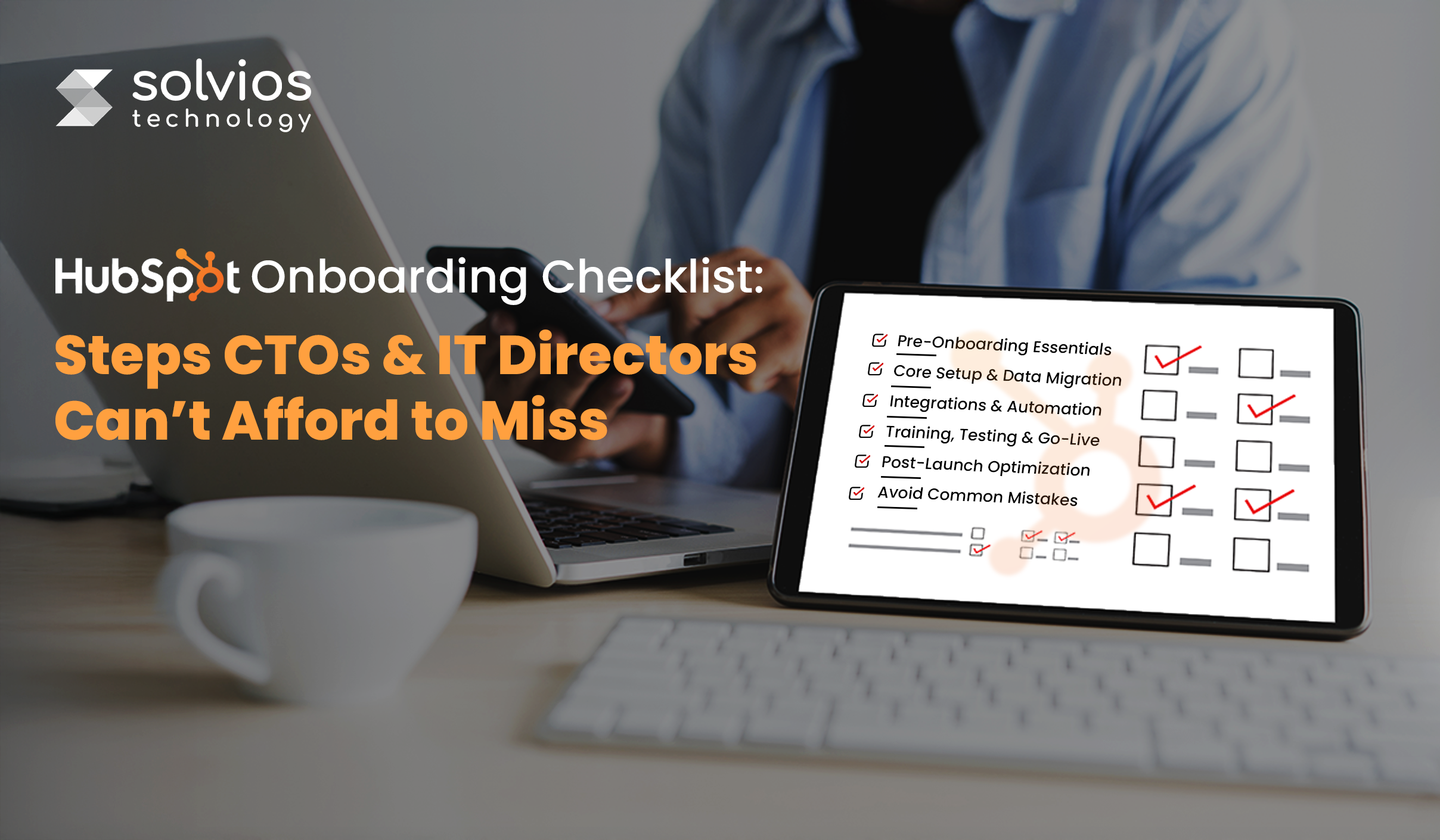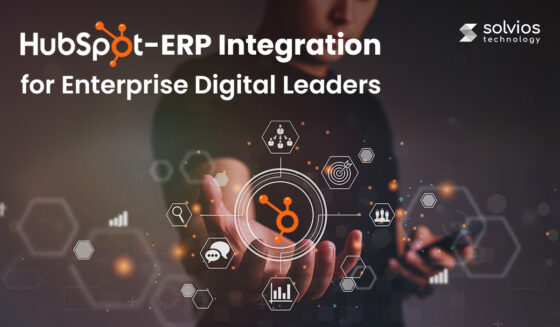
HubSpot is the center of effective operations for businesses around the world. It helps your workforce streamline operations, improve customer satisfaction, and eventually scale.
However, onboarding HubSpot Software is a make-or-break deal. If you don’t onboard properly, you risk wasting your time, losing data, and having your team struggle with the system.
In this guide for CTOs, IT directors, and tech leads, we take a closer look at how business owners like you can streamline the approach. Inside, our experts at Solvios Technology have created a step-by-step checklist to help businesses optimize their platform onboarding process.
Continue reading as we explore a comprehensive HubSpot checklist that turns your experience into a playbook you can use. Also, you can leverage Hubspot’s AI Guide for your business..
Let’s get started.
Pre-Onboarding (Foundation Phase)
Onboarding doesn’t actually start with HubSpot; it starts before the integration phase. You need to set up a pre-onboarding phase using a whiteboard and presenting real numbers related to KPIs, revenue, and goals.
Here are the factors you should look at:
Define Business Objectives & Metrics
What are you chasing – better MQL to SQL conversion, faster onboarding, or simply more reliable lead flow? If the team can’t agree on what success looks like, you’ll end up measuring the wrong things.
Stakeholder Alignment & Roles
One of the biggest mistakes is unclear ownership. Marketing assumes IT will “handle the setup,” and IT assumes marketing “owns HubSpot.” Before you know it, nothing moves. Decide early: who’s the project lead, who needs access, and who’s touching integrations.
Audit Systems & Data
Migrating unclean CRM/ERP data is like moving into a new house with destroyed items from your previous home. Therefore, ensure that you audit your systems and data to identify the gaps before upgrading the system.
Method & ROI
HubSpot’s team offers structure, agencies bring speed, and hybrids balance both. Don’t just look at cost, ask what savings or revenue gains the setup will unlock.
Core Onboarding Checklist (Phases & Tasks)
Planning HubSpot onboarding in stages is the most effective approach. If you skip a step, the procedure will cease to function. To help you understand, below is a breakdown of each phase:
Phase A: Account & Infrastructure Setup
To get started, make an account and confirm the defaults for language, region, and time zone. After that, give your team members their roles and permissions.
Don’t forget that security is not optional. Before installing HubSpot’s tracking code, ensure that 2FA access is enabled, SSO is configured, and your main domain and subdomains are linked.
Before moving to the next step, verify where the data is being captured.
Phase B: Data Migration & Structure
Most projects tend to break down at this point. Therefore, ensure you follow proper structure and practices while migrating data.
Old CRMs are often filled with duplicate contacts, inconsistent fields, and forgotten deals. Clean what you can, map the rest carefully, and test imports in small batches. Think of it as decluttering before moving into a new place.
Additionally, you may also want to define the lifecycle and deal stages at this point; otherwise, sales teams revert to using spreadsheets.
Phase C: Core Hub Setup & Configuration
Every Hub has its own custom settings, which you need to understand. For instance, the Sales Hub requires you to understand:
- Pipelines
- Deal stages
- EEmail templates
- Sequences
Similarly, for Marketing Hub, you need to set metrics for:
- Forms
- CTAs
- Landing pages
- Campaigns
- Lead flows
When moving to Service Hub, set the metrics for:
- Ticket pipelines
- Knowledge base
- Support queues
Remember to configure every purchase that you make. Don’t skip out on settings that might come in handy for your team’s daily use.
Phase D: Integration & Automation
This is where HubSpot becomes the center of your tech stack. Under the integration and automation phase, you need to connect mail and calendar apps to your existing workflow.
Set up the middleware for any customizations within your system. Once the integrations are live and stable, move towards designing the workflows.
Finally, don’t forget to automate your workflow and thoroughly test it. Remember, bad automation is worse than no automation at all.
Phase E: Training, Testing & Launch
Don’t test post-launch; bring live users into the process before you go live. Run training sessions, record brief process videos, and allow teams to explore the features within the sandbox.
Additionally, don’t forget to test the workflow you created in phase D. Quick tests help you catch errors made during setup.
Once you are satisfied with the output, finalize and proceed with the official launch.
Phase F: Post-Launch & Optimization
Onboarding doesn’t end once you’re live; it shifts to tuning mode. Once you’re live, don’t forget to track dashboards, monitor analytics, and run scheduled audits to maintain a clean data set.
Layer in improvements: A/B test workflows, try new sequences, and update content. Additionally, don’t forget to update your setup at regular intervals. Quarterly check-in keeps the team and setup sharp.
Hub-Specific Sidebars You Need to Know
Not every HubSpot rollout looks the same. Each Hub has its own non-negotiables – the ones you may not want to skip. Let’s have a closer look at them in this section.
CRM / Sales Hub Onboarding Highlights
- Pipelines & Stages: Map your real sales process, not a textbook version. If reps already skip steps in spreadsheets, don’t expect them to follow ten stages in HubSpot.
- Templates & Sequences: Save your team from typing the same “just following up” email 50 times.
- Meetings & Calendar: Sync calendars early. Nothing kills adoption faster than reps saying, “It’s easier in Outlook.”
Marketing Hub Onboarding Highlights
- Forms & CTAs: Don’t overcomplicate. Start with one or two forms that actually tie back to campaigns.
- Landing Pages & Campaigns: Launch a test page quickly, then refine. Perfect pages come later.
- Lead Flows: Gentle nudges are more effective than aggressive pop-ups. Treat them like invitations, not intrusions.
Service / Support Hub Onboarding Highlights
- Ticket Pipelines: Keep it simple. Two to three stages are usually enough at the start.
- Knowledge Base: Don’t dump a hundred articles on day one; publish your five most common “how do I?” answers.
- Queues & Automation: Route tickets fairly and efficiently. If one agent is busy, your adoption will yield negative results.
Operations Hub / Automation Focus
- Workflow Sync: Don’t include everything in your workflow. Run a streamlined workflow before you complicate your systems.
- Integrations: Don’t skip testing. Run proper tests to ensure that integrations carefully record the data.
- Automation: Don’t rush to automate everything. Automate various aspects, such as lead routing, data hygiene rules, and a few triggers, once the team trusts the system and is ready to scale.
Pitfalls & Common Onboarding Mistakes to Avoid
- Overlooking Security & Permissions: Don’t hand out admin rights at large from the start. Create robust security and ensure all viable metrics, like 2FA, are aligned with your setup.
- Poor Data Hygiene Before Import: Clean your data before integrating it into HubSpot. Remember, you’ll spend more time cleaning than selling if you feed the system clustered or unstructured data.
- Launching Workflows Without Testing: An untested workflow can lead to operational delays. Therefore, ensure you’ve tested the system in a sandbox before going live.
- Neglecting Integrations: Don’t miss out on integrations for your workflow. Check for emails, calendars, and other possible integrations to keep the systems running smoothly.
- No Roadmap for Post-Launch Optimization: Go-live is just the beginning. Without timely audits, you risk running a system that might fail soon.
When to Bring in HubSpot Experts for Complex Integrations
Some HubSpot projects are fine in-house. Others? You’ll burn weeks trying to solve problems you shouldn’t touch alone.
- Large-Scale Integrations: Legacy ERPs, custom APIs, or homegrown systems are complex. One wrong sync and you’re dealing with terabytes of data. This is where you need to call in the experts.
- Multi-Regional Compliance: GDPR, CCPA… or worse, multiple regions at once. Internal teams often underestimate the complexity. External HubSpot consultants know how to deal with them.
- Massive Data Migration: Migrating millions of records isn’t “import and pray.” It needs careful sequencing, testing, and rollback plans. Agencies already have playbooks in place to avoid downtime for these processes.
- Custom Object Modeling: Scaling with custom modeling can be challenging. You might set it up one way only to regret it six months later. Experts know the traps.
Rule of thumb
If your project feels bigger than your internal team’s appetite, outside help usually pays for itself.
Maximizing ROI with Post-Launch Optimization Strategies (For CTOs & IT Leaders)
When tech leaders ask, “Is onboarding worth the spend?” the honest answer is: it depends on what you value.
Time & Process Gain: A clean rollout saves hours every week. Sales doesn’t double-enter data. Marketing isn’t chasing broken forms. It’s quite efficient.
Fewer Tools, Fewer Headaches: Done right, HubSpot replaces three or four apps. That’s fewer invoices and way fewer integration fires.
Pipeline Lift: Cleaner data and smarter automation result in faster and improved conversions.
Long-Term Payoff: A sloppy setup can result in callbacks every year. However, things are different when working with professionals. You seek their expertise once and get a system that scales forever.
Conclusion
Adding HubSpot to your business is more than just a one-time thing. It helps you build your business and makes scaling it easy.
If you’re truly looking to expand, don’t forget to contact our specialists at Solvios Technology to learn more about our services. Hurry up and make a call today!
Ready to Streamline Your HubSpot Onboarding? Contact Our Experts Today!
Contact us for HubSpot consulting services.Frequently Asked Question
Many companies overlook critical steps such as cleaning their data before import, aligning stakeholder roles, and testing workflows before going live. Skipping these can lead to system confusion, operational delays, and difficulty in maximizing HubSpot’s ROI
Effective HubSpot onboarding starts before migration by thoroughly auditing and cleaning CRM/ERP data, mapping fields accurately, and fixing inconsistencies, all to prevent future complications and ensure a smooth transition.
Key integrations include connecting mail, calendar apps, and any middleware necessary for customizations, followed by building and testing streamlined workflows that automate critical business processes without overwhelming the team.
External help is recommended for large-scale integrations like legacy ERPs, multi-regional compliance, massive data migrations, or custom object modeling—scenarios where in-house teams typically face risks and extended delays.
Post-launch, businesses should regularly monitor dashboards, run scheduled audits, A/B test workflows, and update configurations quarterly to keep both the team and the HubSpot instance operating at peak efficiency.
Tags
Related Blog
Want to get started with App Development?
These applications are acquiring enormous prevalence by offering hands-on enterprise mobility solutions for organizations around the globe.
Start A Conversation















